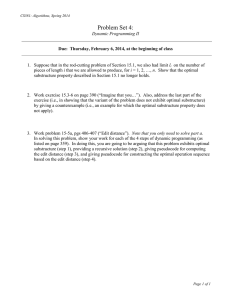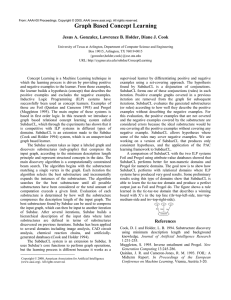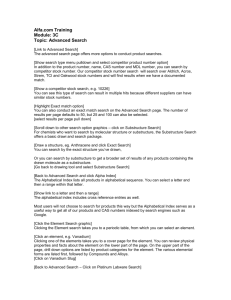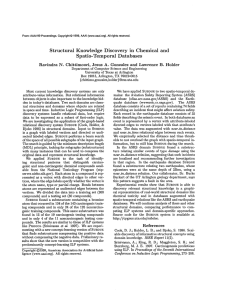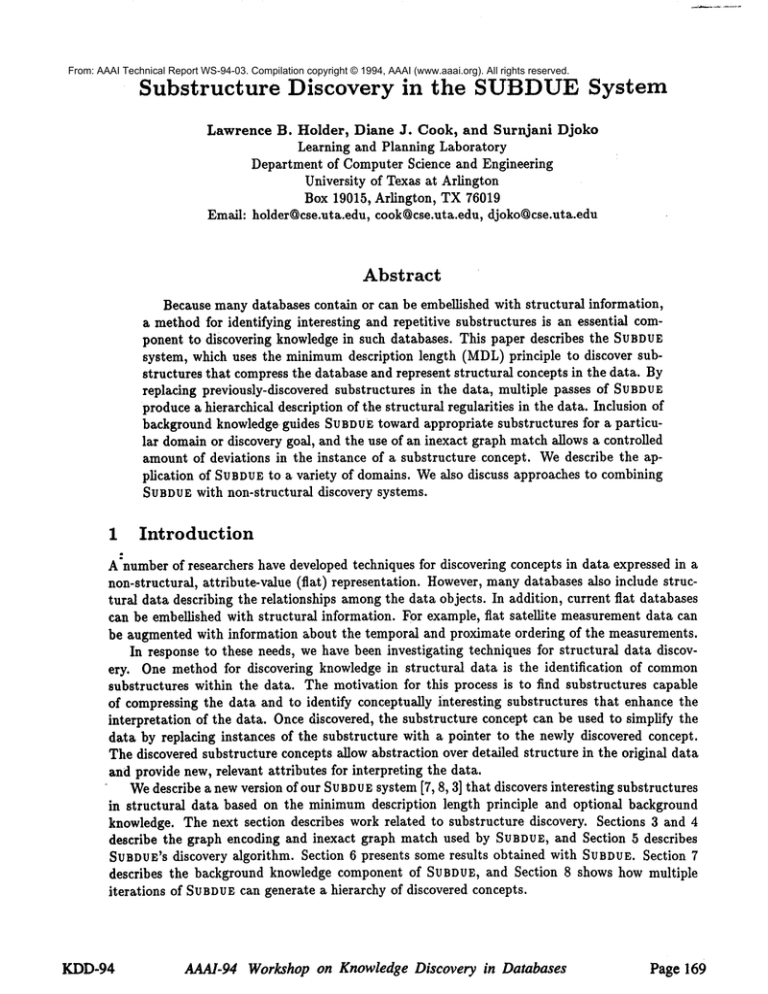
From: AAAI Technical Report WS-94-03. Compilation copyright © 1994, AAAI (www.aaai.org). All rights reserved.
Substructure
Discovery
in the
SUBDUESystem
Lawrence B. Holder, Diane J. Cook, and Surnjani
Djoko
Learning and Planning Laboratory
Department of Computer Science and Engineering
University of Texas at Arlington
Box 19015, Arlington, TX 76019
Emaih holder~cse.uta.edu,
cook~cse.uta.edu, djoko~cse.uta.edu
Abstract
Because manydatabases contain or can be embellished with structural information,
a methodfor identifying interesting and repetitive substructures is an essential component to discovering knowledge in such databases. This paper describes the SUBDUE
system, which uses the minimumdescription length (MDL)principle to discover substructures that compress the database and represent structural concepts in the data. By
replacing previously-discovered substructures in the data, multiple passes of SUBDUE
produce a hierarchical description of the structural regularities in the data. Inclusion of
background knowledgeguides SUBDUE
toward appropriate substructures for a particular domainor discovery goal, and the use of an inexact graph match allows a controlled
amount of deviations in the instance of a substructure concept. Wedescribe the application of SUBDUE
to a variety of domains. Wealso discuss approaches to combining
SUBDUE
with non-structural discovery systems.
1
Introduction
A number of researchers have developed techniques for discovering concepts in data expressed in a
non-structural, attribute-value (fiat) representation. However, manydatabases also include structural data describing the relationships amongthe data objects. In addition, current fiat databases
can be embellished with structural information. For example, fiat satellite measurement data can
be augmented with information about the temporal and proximate ordering of the measurements.
In response to these needs, we have been investigating techniques for structural data discovery. One method for discovering knowledge in structural data is the identification
of common
substructures within the data. The motivation for this process is to find substructures capable
of compressing the data and to identify conceptually interesting substructures that enhance the
interpretation of the data. Once discovered, the substructure concept can be used to simplify the
data by replacing instances of the substructure with a pointer to the newly discovered concept.
The discovered substructure concepts allow abstraction over detailed structure in the original data
and provide new, relevant attributes for interpreting the data.
Wedescribe a newversion of our S u B DUE system [7, 8, 3] that discovers interesting substructures
in structural data based on the minimumdescription length principle and optional background
knowledge. The next section describes work related to substructure discovery. Sections 3 and 4
describe the graph encoding and inexact graph match used by SUBDUE,
and Section 5 describes
SUBDUE’S
discovery algorithm. Section 6 presents some results obtained with SUBDUE.
Section 7
describes the background knowledge component of SUBDUE,and Section 8 shows how multiple
iterations of SUBDUE
can generate a hierarchy of discovered concepts.
KDD-94
AAAI-94 Workshop on Knowledge Discovery
in Databases
Page 169
Eventually, the SUBDUE
system must be integrated with methods for discovery in fiat data.
Although SUBDUE
can accept fiat data as input, the discovery process has no model for the distribution of attribute values. Therefore, every value is distinct and unrelated to other values.
Section 9 discusses approaches to integrating SUBDUE
with non-structural discovery systems such
as AUTOCLASS
[1] which provide for the inclusion of distribution models. Section 10 summarizes
our results with SUBDUE
and discusses directions for future work.
2
Related
Work
Although specific to the blocks-world domain, Winston’s ARCH
program [24] discovers substructure
in order to deepen the hierarchical description of a scene and to group objects into more general
concepts. Levinson [11] developed a system~for storing labeled graphs in which individual graphs
are represented by the set of vertices in a universal graph. Subgraphs of the universal graph used
by several individual graphs suggest commonsubstructure in the individual graphs. Segen [20]
describes a system for storing graphs using a probabilistic graph model to represent classes of
graphs. High-probability components of the model represent substructure commonto the model’s
instances.
The LABYRINTH
system [21] extends the COBWEB
incremental conceptual clustering system
[5] to form hierarchical concepts of the structured objects. The upper-level components of the
structured-object
hierarchy represent substructures commonto the input objects. Conklin and
Glasgow[2] have developed the I-MEMsystem for constructing an image hierarchy, similar to that
of LABYRINTH,
used for discovering commonsubstructure in a set of images expressed in terms of
a set of predefined relations. The CLIPsystem [25] for graph-based induction iteratively discovers
patterns (substructures) in graphs by expanding and combining patterns discovered in previous
iterations.
CLIP addresses the computational complexity by estimating compression afforded by
the substructures and using a linear-time approximation to graph isomorphism.
Manyresults in grammatical inference are applicable to constrained classes of graphs (e.g.,
trt~s) [6, 13], and discover graph-based production rules that can be in~terpreted as substructures
commonto the input graphs [9].
3
Encoding Graphs
The minimumdescription length (MDL)principle introduced by Rissanen [19] states that the best
theory to describe a set of data is that theory which minimizes the description length of the entire
data set. The NIDLprinciple has been used for decision tree induction [17], image processing
[10, 14, 15], concept learning from relational data [4], and learning models of non-homogeneous
engineering domains [18].
Wedemonstrate how the minimumdescription length principle can be used to discover substructures in complex data. In particular, a substructure is evaluated based on howwell it can
compress the entire dataset using the minimumdescription length. We define the minimumdescription length of a graph to be the number of bits necessary to completely describe the graph.
According to the minimumdescription length (NIDL) principle, the theory that best accounts for
a collection of data is the one that minimizesI(S)+ I(G[ S), where S is the discovered substructure,
G is the input graph, I(S) is the number of bits required to encode the discovered substructure,
and I(G|S) is the number of bits required to encode the input graph G with respect to S.
The encoding of the graph consists of the following steps. The graph connectivity can be
represented by an adjacency matrix, where a value of 1 in entry ij represents at least one edge from
Page 170
AAAI-94 Workshop on Knowledge Discovery
in Databases
KDD-94
i to j. Weassume that that the original graph G has n vertices and that the decoder has a table
of the l~, unique labels in G.
Determine
thenumber
of bitsvbitsneeded
to encode
thevertex
labels
of thegraph.
First,
we
need(Igv) bitsto encode
thenumber
of vertices
v in thegraph.
Then,encoding
thelabels
ofallv vertices
requires
(vlgl~,)bits.
We assume
thevertices
arespecified
in thesameorder
theyappear
in theadjacency
matrix.
Thetotalnumber
of bitsto encode
thevertex
labels
is
vbits = lg v + v lg l~,.
.
Determine the number of bits rbits needed to encode the rows of the adjacency matrix A.
Typically, in large graphs, a single vertex has edges to only a small percentage of the vertices
in the entire graph. Therefore, a typical row in the adjacency matrix will have muchfewer
than v Is, where v is the total number of vertices in the graph. Weapply a variant of the
coding scheme used by Quinlan and Rivest [17] to encode bit strings with length n consisting
of k Is and (n - k) 0s, where k ~ (n - k). In our case, row i (1 < i _~ v) can be represented
as a bit string of length v containing kl Is. If we let b = maxi kl, then the i th row of the
adjacency matrix can be encoded as follows.
(a)Encoding
thevalue
of ki requires
lg(bq-I) bits.
of length
v, onlyC(v,ki)strings
of
(b)Giventhatonlyki ls occurin therowbitstring
0s andls arepossible.
Sinceallof thesestrings
haveequalprobability
of occurrence,
IgC(v,
ki)bitsareneeded
to encode
thepositions
of ls in rowi. Thevalueofv is known
fromthevertexencoding.
Finally,
we needan additional
Ig(b+ I) bitsto encode
thenumber
of bitsneeded
to specify
thevalueof ki foreachrow.Thetotalencoding
length
in bitsfortheadjacency
matrix
is
rbits = lg(b + 1) + ~i~1 lg(b + 1) + C(v, ki)
3. Determine
thenumberof bitsebitsneededto encodetheedgesrepresented
by theentries
" A[i,j]= 1 of theadjacency
matrixA. Thenumberof bitsneededto encodeentryA[i,j]is
(Igm) + e(i,j)[1+ Ig lu],wheree(i,j) istheactual
number
ofedges
between
vertex
i andj in
thegraphandm = maxl
e(i,j).
The
(Igm)
bits
are
needed
to
encode
the
number
of edges
d
between
vertex
i andj, and[I + Ig/u]bitsareneeded
peredgeto encode
theedgelabeland
whether
theedgeis directed
or undirected.
In addition
to encoding
theedges,we needto
encodethenumber
of bits(Igm) needed
to specify
thenumber
of edgesperentry.
Thetotal
encoding of the edges is ebits = lgrn + ~"~iv=l ~--~v
j----1lgra + e(i,j)[1 lg/~].
The total encoding of the graph takes (vbits + rbits + ebits) bits. Both the input graph and
discovered substructure can be encoded using the above scheme. After a substructure is discovered,
each instance of the substructure in the input graph is replaced by a single vertex representing
the entire substructure. The labels of edges incident on the vertices of a substructure instance
can be changed to indicate the specific vertex within the substructure involved in the edge. The
discovered substructure .is represented in I(S) bits, and the graph after the substructure replacement
is represented in I(G[S) bits. SUBDUE
searches the space of possible substructures, preferring
substructures S needing less information I(S)+ I(G[S) to describe the graph G.
4
Inexact Graph Match
Although
exactstructure
matchcanbe usedto findmanyinteresting
substructures,
manyof the
mostinteresting
substructures
showup in a slightly
different
formthroughout
thedata.These
KDD-94
AAAI-94 Workshop on Knowledge Discovery
in Databases
Page 171
SU BDUE(G,limit,beam)
S = vertices(G)
while (computation < limit) and (S ~ {))
order S from best to worst using MDLand background knowledge rules
S = first beamsubstructures of S
b = first(S)
D=DN{b)
E = {b extended by one edge in all possible ways )
S=SNE
return D
Figure 1: SUBDUE’s
discovery algorithm.
differences may be due to noise and distortion, or mayjust illustrate slight differences between
instances of the same general class of structures. Consider the image shownin Figure 3. The pencil
and the cube would make ideal substructures in the picture, but an exact match algorithm may
not consider these as strong substructures, because they rarely occur in the same form throughout
the picture.
To allow a controlled amountof variation between instances of a substructure, we use an inexact
graph match. In this algorithm, each distortion of a graph is assigned a cost. A distortion is
described in terms of basic transformations such as deletion, insertion, and substitution of vertices
and edges. The distortion costs can be determined by the user to bias the match for or against
particular types of distortions.
An inexact graph match between two graphs gl and g2 maps gl to g2 such that g2 is interpreted
as.a distorted version of gl. Given a set of particular distortion costs, we define matehcost(gl, g2)
as" the value of the least-cost function that maps graph gl onto graph g2. Although there are
an exponential number of mappings to consider, we reduce the complexity of the algorithm by
performing a branch-and-bound search through the space of partial mappings. Whenever the
numberof substructure instances affects the substructure value, instances of a substructure can be
weighted by their similarity to the substructure definition.
5
SUBDUE’s Discovery
Algorithm
Input to SUBDUE
is in the form of a labeled, directed multigraph (two vertices mayhave more than
one edge between them). A substructure is a connected subgraph within the graphical representation. An instance of a substructure in an input graph is a set of vertices and edges from the input
graph whose match cost (according to the inexact graph match) to the graphical representation
the substructure is no more than a given threshold.
The substructure discovery algorithm used by SUBDUE
is a computationally-constrained
beam
search (see Figure 1). The algorithm begins with the substructure matching a single vertex
the graph. Each iteration through the algorithm selects the best substructures and expands the
instances of these substructures by one neighboring edge in all possible ways. The algorithm retains
the best substructures in a list, which is returned wheneither all possible substructures have been
considered or the total amount of computation exceeds a given limit. The evaluation of each
Page 172
AAAI-94 Workshop on Knowledge Discovery
in Databases
KDD-94
\
ON
H
70
H
"°’F°
%
),l.~m
b)o
~--ooH
¢)
o\
/
.
3
°--~o°X
.-x-’~
\
"
Ho-¢"o
0
Figure 2: a) Natural rubber, b) Cortisone, c) Portion of a DNAmolecule
substructure is guided by the minimumdescription
rules provided by the user (see Section 7).
6
length principle
and background knowledge
Domains
Tlfe databases used in our experiments are taken from the domains of chemical compoundanalysis,
scene analysis, CADcircuit analysis, and analysis of artificially-generated
graphs. In the chemical compounddomain, individual atoms are represented by vertices in the graph and bonds are
represented by labeled edges in the graph. Figures 2 shows the graphs that were used for our
experiments.
To apply SUBDUE
to image data, we extract edge information from the image and construct a
graph representing the scene. The vertex labels follow the Waltz ]abelings [22] of junctions of edges.
An edge arc represents the edge of an object in the image, and a space arc links non-connecting
objects together. Figure 3 shows the scene used for our experiments.
The data for the CADcircuit domain was obtained from National Semiconductor, and consists of
a set of components making up a circuit as output by the Cadence Design System. The particular
circuit used for this experiment is a portion of an analog-to-digital converter. In this domain,
each component and interconnection is represented by a vertex labeled with the component name
or T (interconnection).
Each connection between components and between interconnections
represented by an arc.
In the final domain, we artificially
generate graphs to evaluate SUBDUE’S
ability to discover
substructures capable of compressing the graph. Four substructures are created of varying sizes
and embeddedin larger graphs whose size is 15 times the size of the substructure. The graphs vary
across four parameters: numberof possible vertex and edge labels, connectivity of the substructure,
coverage of the instances, and the amountof distortion in the instances, totaling 96 graphs.
KDD-94
AAA1-94 Workshop on Knowledge Discovery
in Databases
Page 173
Figure 3: Scene analysis example.
Database
Rubber
Cortisone
DNA
Pencils
CAD - M1
CAD- SiSegDec
CAD - SIDrvBlk
CAD - BlankSub
CAD - And2
Artificial (avg of 96 graphs)
DLori~
371.78
355.03
2427.93
1592.33
4095.73
1860.14
12715.12
8606.69
427.73
1636.25
Threshold
0.1
0.3
1.0
1.0
0.7
0.7
0.7
0.7
0.1
0.0...1.0
DLcomp Compression
95.20
0.26
173.25
0.49
2211.87
0.91
769.18
0.48
0.52
2148.8
1149.29
0.62
0.71
9070.21
6204.74
0.72
324.52
0.76
1164.02
0.71
Table 1: Graph compression results.
In our first experiment, we test SUBDUERSability to compress a structural database. Weapplied
the discovery algorithm to each ofthe databases mentioned above. All subgraphs with a matchcost
less than or equal to a specified threshold are included as instances of a substructure. Werepeat
the experiment with match thresholds ranging from 0,0 to 1.0 in increments of 0.1. Table 1 lists
,-,
¯ . ~ ~, J ._ DescrjptionLengtl~
of compressed
graph
the results of this experiment,wompresslonis aennea ~s DescriptionLengthof original graph " These
results demonstrate that even a single substructure discovered by SUSDUE
can significantly reduce
the amount of data needed to represent an input graph.
7
Background
Knowledge
Although the principle of minimumdescription length is useful for discovering substructures that
maximize compression of the data, scientists may realize more benefit from the discovery of substructures that exhibit other domain-specific and domain-independent characteristics.
To make SUBDUe.more powerful across a wide variety of domains, we have added the ability
to guide the discovery process with background knowledge. Although the minimumdescription
Page 174
AAAI-94 Workshopon KnowledgeDiscoveryin Databases
KDD-94
length principle still drives the discovery process, the background knowledgecan be used to input
a bias toward certain types of substructures. This background knowledge is encoded in the form
of rules for evaluating substructures, and can represent domain-independent or domain-dependent
rules. Each time a substructure is evaluated, these input rules are used to determine the value of
the substructure under consideration. Because only the most-favored substructures are kept and
expanded, these rules bias the discovery process of the system.
Each background rule can be assigned a positive, zero, or negative weight, that biases the
procedure toward a type of substructure, eliminates the use of the rule, or biases the procedure
away from a type of substructure, respectively. The value of a substructure is defined as the
description length of the input graph using the substructure multiplied by the weighted value of
each background rule from a set of rules R applied to the substructure.
IRI
value(s) = DL(G,s) "r
× lI ruler(s)
r----1
Twoof the domain-independent heuristics that have been incorporated as rules into the SUBDU~. system are compactness and coverage. The first rule, compactness, is a generalization of
Wertheimer’s Factor of Closure, which states that humanattention is drawn to dosed structures
[23]. A dosed substructure has at least as manyedges as vertices, whereas a non-closed substructure has fewer edges than vertices [16]. Compactnessis thus defined as the ratio of the number of
edges in the substructure to the numberof vertices in the substructure.
The second rule, coverage, measures the fraction of structure in the input graph described by
the substructure. The coverage rule is motivated from research in inductive learning and provides
that concept descriptions describing more input examples are considered better [12]. Although
the MDLprinciple measures the amount of structure, the coverage rule includes the relevance of
this savings with respect to the size of the entire input graph. Coverage is defined as the number
of unique vertices and edges in the instances of the substructure divided by the total number of
vertices and edges in the input graph.
" Domain-dependent rules can also be used to guide the discovery process in a domain where
scientists can contribute their expertise. For example, circuit componentscan be classified according
to their passivity. A componentis said to be passive if it never delivers a net amountof energy to
the outside world. A component which is not passive is said to be active. The active component
rule favors substructures containing an active component. Once the active components are selected
by SUBDUE,
they can be compressed and attention can be focused on the passive components. This
rule could also be weighted negatively to exclude substructures with active components. Similarly,
the loop analysis rule favors subcircuits containing loops. A loop is defined here as a closed path
whosestarting vertex is the same as its ending vertex.
The substructure affording the most compression will not always be the most interesting or
important substructure in the database. However, the additional background rules can be used
to increase the chance of finding interesting substructures in these domains. In the case of the
cortisone compound, we might be interested in finding commonclosed structures such as benzene
rings. Therefore, we give a strong weight (8.0) to the compactness background rule and use a
match threshold of 0.2 to allow for deviations in the benzene ring instances. In the resulting
output, SUBDUE
finds the benzene ring shown in Figure 4a.
In the same way, we can use the background rules to find the pencil substructure in the image
data. Weknow that the pencils have a high degree of closure and of coverage, so the weights for
these rules are set to 1.0. With these weights, SUBDUE
is able to find the pencil substructure shown
in Figure 4b for all tested match thresholds between 0.0 and 1.0.
KDD-94
AAAI-94 Workshopon KnowledgeDiscoveryin Databases
Page 175
a)
b)
Figure 4: Results of Subdue guided by background knowledge
R2
V
1 DD
R3:~
,I
R4
"~I_.
---
Q
~___
V~
VO
b) SUBDUE
with BackgroundKnowledge
a) Original Database
c) SUBDUE
without BackgroundKnowledge
Figure 5: CADcircuit and discovered substructures
As a final example, the circuit shown in Figure 5a is passed to SUBDUE
with a weight of 1.0
for the active component rule and a weight of 3.0 for the loop rule. The substructure discovered
by SUBDUE
is identified as a difference amplifier, whereas the substructure discovered by SUBDUE
using no background knowledge exhibits now knownfunctionality.
8
Hierarchical
Concept Discovery
After a substructure is discovered, each instance of the substructure in the input graph can be
replaced by a single vertex representing the entire substructure. The discovery procedure can then
be repeated on the compressed data set, resulting in new interesting substructures. If the newlydiscovered substructures are defined in terms of existing substructure concepts, the substructure
definitions form a hierarchy of substructure concepts.
Hierarchical concept discovery also adds the capability to improve SUBDUE’S
performance.
WhenSUBDUE
is applied to a large input graph, the complexity of the algorithm prevents consideration of larger substructures. Using hierarchical concept discovery, SUBDUE
can first discover those
smaller substructures which best compress the data. Applying the compression reduces the graph
to a more manageable size, increasing the chance that SUBDUE
will find the larger substructures
on the subsequent passes through the database.
Once SUBDUE
selects a substructure, all vertices that comprise the exact instances of the substructure are replaced in the graph by a single vertex representing the discovered substructure.
Edges connecting vertices outside the instance to vertices inside the instance nowconnect to the
new vertex. Edges internal to the instance are removed. The discovery process is then applied to
the compressed data.
Page 176
AAA1.94 Workshop on Knowledge Discovery
in Databases
KDD-94
P
Figure 6: Hierarchical discovery in DNAdata.
structural
component -~ Subdue I
data
AutoClass ~ classification
non-structural
component
Figure 7: Integration of Subdue and AutoClass.
To demonstrate the ability of SUBDUEto find a hierarchy of substructures, we let the system
make multiple passes through a database that represents a portion of a DNAmolecule. Figure 2
shows a portion of two chains of a double helix, using three pairs of bases which are held together
by hydrogen bonds. Figure 6 shows the substructures found by SUBDUE
after each of three passes
through the data. Substructure s3 represents each of the two chains in the DNAmolecule. As
opposed to the 0.91 factor of compression for the DNAdatabase shown in Table 1, the factor of
compression after running three passes of SUBDUE
through this database is 0.56.
9
Integration
with Non-Structural
Discovery
One weakness of the SUBDUE
system is the inability to incorporate models of non-structural attribute values. For example, Jf objects in the domain have a temperature that ranges from 0 to
100, SUBDUE
considers the values 50.0001 and 50.0002 as different as 0 and 100. Knowledgeabout
the distribution of attribute values is necessary to appropriately match this type of data in the
substructures. One possibility is to infer the parameters of a normal model for each attribute from
the data and use this information to affect the match cost of two graphs. Another possibility is to
use SUBDUE
as a pre-processor of the structural component of the data in order to construct new
non-structural attributes for addition to the set of existing, non-structural attributes. The new set
of attributes can then be processed by a nonstructural discovery method, in which the discovered
concepts will be biased by the inclusion of structural information.
We are pursuing the second possibility by investigating the integration of SUBDUE
with the
AUTOCLASS
system [1]. AUTOCLASS
is an unsupervised, non-structural
discovery system that
identifies a set of classes describing the data. Each attribute is described by a given model (e.g.,
normal), and each class is described by particular instantiations of the models for each attribute.
AUTOCLASS
searches for the classification maximizing the conditional probability of the data given
the classification.
Figure 7 diagrams the proposed integration
of SUBDUE
and AUTOCLASS. First, SUBDUE
is
KDD-94
AAAI-94 Workshopon KnowledgeDiscoveryin Databases
Page 177
run on the structural componentof the data to produce prevalent substructures in the data. For
each discovered substructure, the vertices of the substructure (which correspond to individual
objects or examples in the non-structural data component) become new attributes whose values
reflect the degree with which that particular object or example participates as the vertex in the
substructure. For example, if SUBDUE
discovered a substructure consisting of two vertices and one
edge, then two new, non-structural attributes would be added to the original attributes of each data
object. The value of the first new attribute, corresponding to the first vertex of the substructure,
measures the degree to which the object occurs as this vertex in an instance of the substructure.
Likewise, the second new attribute measures a similar value corresponding to the second vertex of
the substructure. These values can be determined by the match cost between the substructure and
the instance containing the object.
The new data, augmentedwith this non-structural information about the structural regularities
in the data, can now be passed to the AUTOCLASS
system. The structural information will bias the
classifications preferred by AUTOCLASS
towards those consistent with the structural regularities in
the data. Implementation of the integrated discovery system is underway. Weplan to evaluate the
integration
of SUBDUE
and AUTOCLASS
by comparing the results of AUTOCLASS
alone on data
with a weak, non-structural classification and a strong, structural classification. Wealso plan to
compare previous AUTOCLAsS
results with the classifications obtained with the integrated discovery
system using the same data augmented with natural structural information such as temporal and
proximate ordering.
I0
Conclusions
Discovering knowledge in data containing structural information can be achieved by identifying
repetitive substructures in the data. The substructures represent new concepts found in the data
and a meansof reducing the complexity of the data by abstracting over instances of the substructure.
The S u B v u E system provides a methodfor discovering substructures in data expressed as a labeled,
directed graph. We have shown how the minimumdescription length principle and background
knowledge used by SUBDUE
can guide substructure discovery in a variety of domains. Once a
substructure is discovered, instances of the substructure can be replaced by the concept definition.
This affords compressionof the data description and provides a basis for discovering hierarchicallydefined structures.
The next step is to extend SUBDUE
by adding the ability to intelligently handle non-structural
data. Current efforts are underway to integrate SUBDUE
and AUTOCLASS, and methods for including attribute value models into the inexact graph match are also under investigation. The large
amount of structural information that can be added to non-structural data collected on physical
phenomenaprovides a large testbed for comparing an integrated discovery system based on SUBDUP,
to other non-structural discovery systems.
Acknowledgements
The authors would like to thank Pat Langley for numerous commentsregarding the evaluation of
our system. We would also like to thank Tom Lai for implementing an improved graph match
procedure. This work is supported by NASAgrant NAS5-32337.
Page 178
AAAI-94 Workshop on Knowledge Discovery
in Databases
KDD-94
References
J. Kelly,M. Self,J. Stutz,
W. Taylor,
andD. Freeman.
Autoclass:
A bayesian
[1]P. Cheeseman,
classification system. In Proceedings of the Fifth International Conference on Machine Learning, pages 54-64, 1988.
[2] D. Conklin, S. Fortier, J. Gl~gow, and F. Allen. Discovery of spatial concepts in crystallographic databases. In Proceedings of the ML92 Workshop ’on Machine Discovery, pages
111-116, 1992.
[3] D. J. Cook and L. B. Holder. Substructure discovery using minimumdescription length and
background knowledge. Journal of Artificial Intelligence Research, 1:231-255, 1994.
[4] M. Derthick. A minimal encoding approach to feature discovery. In Proceedings of the Ninth
National Conference on Artificial Intelligence, pages 565-571, 1991.
[5] D. H. Fisher. Knowledgeacquisition via incremental conceptual clustering.
2(2):139-172, 1987.
Machine Learning,
[6] K. S. Fu. Syntactic Pattern Recognition and Applications. Prentice-Hall, 1982.
[7] L. B. Holder and D. J. Cook. Discovery of inexact concepts from structural
Transactions on Knowledge and Data Engineering, 5(6):992-994, 1993.
data. IEEE
[8] L. B. Holder, D. J. Cook, and H. Bunke. Fuzzy substructure discovery. In Proceedings of the
Ninth International Conference on Machine Learning, pages 218-223, 1992.
[9] E. Jeltsch and H. J. Kreowski. Grammatical inference based on hyperedge replacement. In
Fourth International Workshop on Graph Grammarsand Their Application to Computer Science, pages 461-474, 1991.
Y. G. Leclerc.
[1o]
Constructing simple stable descriptions for image partitioning.
Journal of Computational Vision, 3(1):73-102, 1989.
International
[II]R. Levinson. A self-organizing retrieval system for graphs. In Proceedings of the Fourth
National Conference on Artificial Intelligence, pages 203-206, 1984.
[12]R.
S. Michalski and R. E. Stepp. Learning from observation: Conceptual clustering. In R. S.
Michalski, J. G. Carbonell, and T. M. Mitchell, editors, Machine Learning: An Artificial
Intelligence Approach, pages 331-363. Tioga Publishing Company,1983.
[13] L. Miclet. Structural
Methods in Pattern Recognition. Chapmanand Hall, 1986.
[14]E.
P. D. Pednault. Someexperiments in applying inductive inference principles to surface
reconstruction. In Proceedings of the Eleventh International Joint Conference on Artificial
Intelligence, pages 1603-1609, 1989.
[15]A. Pentland. Part segmentation for object reco~uition. Neural Computation, 1:82-91, 1989.
R. Prather.
[16]
Discrete Mathemetical Structures
for Computer Science. Houghton MimnCom-
pany, 1976.
[17]
J. R.
Quinian and R. L. Rivest. Inferring decision trees using the minimumdescription length
principle. Information and Computation, 80:227-248, 1989.
KDD-94
AAAI-94 Workshopon KnowledgeDiscoveryin Databases
Page 179
[18] R. B. Rao and S. C. Lu. Learning engineering models with the minimumdescription length
principle. In Proceedings of the Tenth National Conference on Artificial Intelligence, pages
717-722, 1992.
[19] J. Rissanen. Stochastic Complexity in Statistical
1989.
Inquiry. World Scientific Publishing Company,
[20]J.
Segen. Graph clustering and model learning by data compression. In Proceedings of the
Seventh International Conference on Machine Learning, pages 93-101, 1990.
[21] K. Thompsonand P. Langley. Concept formation in structured domains. In D. H. Fisher and
M. Pazzani, editors, Concept Formation: Knowledge and Experience in Unsupervised Learning,
chapter 5. Morgan Kaufmann Publishers, 1991.
[22] D. Waltz. Understanding line drawings of scenes with shadows. In P. H. Winston, editor,
Psychology of Computer Vision. McGraw-Hill, 1975.
The
[23] M. Wertheimer. Lawsof organization in perceptual forms. In W. D. Ellis, editor, A Sourcebook
of Gestalt Psychology, pages 331-363. Harcourt, Brace and Company,1939.
[24] P. H. Winston. Learning structural descriptions from examples. In P. H. Winston, editor, The
Psychology of Computer Vision, pages 157-210. McGraw-Hill, 1975.
[25] K. Yoshida, H. Motoda, and N. Indurkhya. Unifying learning methods by colored digraphs.
In Proceedings of the Learning and Knowledge Acquisition Workshop at IJCAI-g3, 1993.
Page 180
AAAI-94 Workshop on Knowledge Discovery
in Databases
KDD-94

